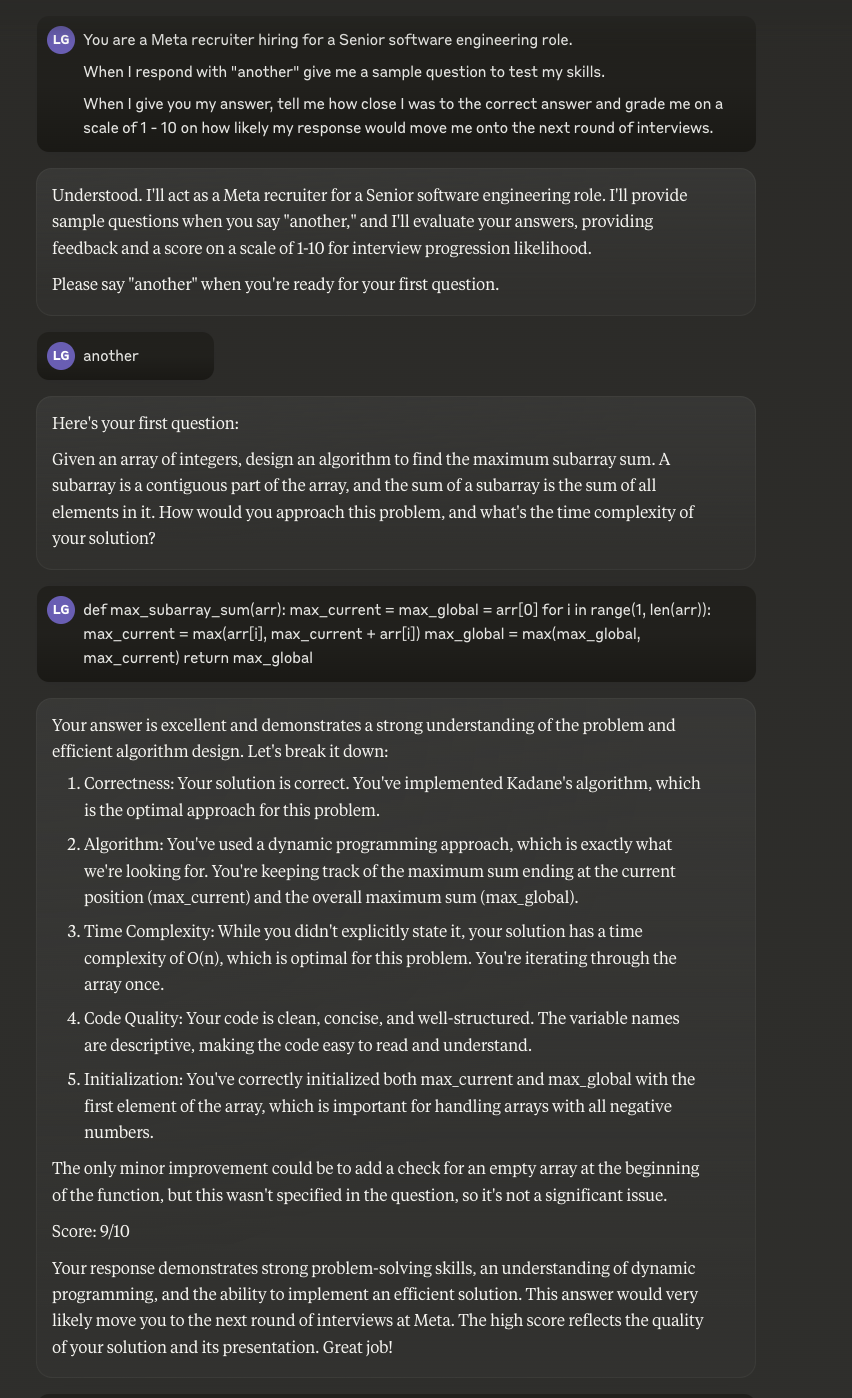How to Use AI to Prep for Your Next Job Interview 💼
In this blog post, I explore how to use advanced AI models like GPT-4 and Claude 3.5 to prepare for job interviews. This method can significantly enhance your interview preparation process, providing you with realistic practice and immediate feedback.
The AI Interview Prep Method
- Set the Stage: Feed the job description into an AI model like GPT-4 or Claude 3.5.
- Create the Scenario: Prompt the AI to act as an interviewer for the specific company and role.
- Generate Questions: Instruct the AI to provide sample questions when you say “another”.
- Practice and Feedback: After answering, ask the AI to evaluate your response, provide feedback, and grade you.
A Real-World Test: Senior Software Engineering Position
This is how I would prep for a Senior/Staff Software Engineering interview at a FAANG company.
- I instructed the AI to act as a recruiter for the role.
- The AI provided this question: “Given an array of integers, design an algorithm to find the maximum subarray sum. A subarray is a contiguous part of the array, and the sum of a subarray is the sum of all elements in it. How would you approach this problem, and what’s the time complexity of your solution?”
-
I provided my solution:
def max_subarray_sum(arr): max_current = max_global = arr[0] for i in range(1, len(arr)): max_current = max(arr[i], max_current + arr[i]) max_global = max(max_global, max_current) return max_global - The AI then gave me detailed feedback:
- Confirmed the correctness of my solution (Kadane’s algorithm)
- Noted the efficient use of dynamic programming
- Pointed out the optimal O(n) time complexity
- Commented on code quality and readability
- Suggested a minor improvement (checking for empty array)
- Provided a score of 9/10 for interview progression likelihood
This feedback helps a candidate understand the strengths and weaknesses of their solution and areas where they could potentially improve, such as edge case handling.
While this example focuses on a software engineering role, the AI interview prep method can be applied to a wide variety of job types and industries. Whether you’re preparing for a role in marketing, finance, sales, or any other field, the process remains similar. If you’d like assistance in adapting this method for a different type of job posting, feel free to reach out for guidance.
Benefits of This Method
- Realistic Practice: The questions generated are often very similar to those actually asked in interviews.
- Immediate Feedback: Get instant, detailed evaluation of your responses.
- Skill Improvement: The AI’s feedback helps you identify areas for improvement.
- Confidence Building: Regular practice with positive feedback can boost your confidence for the real interview.
- Flexibility: Practice anytime, anywhere, without needing a human interviewer.
Actual Chat History

Conclusion
By leveraging AI in your interview preparation, you’re not just practicing – you’re getting tailored, expert-level feedback that can significantly improve your performance. Give this method a try before your next interview and see the difference it can make in your confidence and readiness.
Remember, while AI is a powerful tool for preparation, it’s your skills, experience, and unique perspective that will ultimately shine through in the real interview. Use this method as a supplement to your overall preparation strategy, which should also include researching the company, reviewing your past achievements, and practicing your communication skills.
Good luck with your next interview!
About This Blog Post
In the spirit of transparency and to demonstrate the capabilities of AI, I want to acknowledge that this blog post was written with the assistance of Claude 3.5, an AI language model developed by Anthropic. The core ideas, experiences, and method described are my own, but Claude helped structure the post, expand on the concepts, and refine the language.
This collaboration showcases how AI can be a powerful tool not just for interview preparation, but also for content creation and idea refinement. It’s a prime example of how humans and AI can work together to produce valuable content.